(6)第五章水蒸气与湿空气
- 格式:ppt
- 大小:5.09 MB
- 文档页数:31
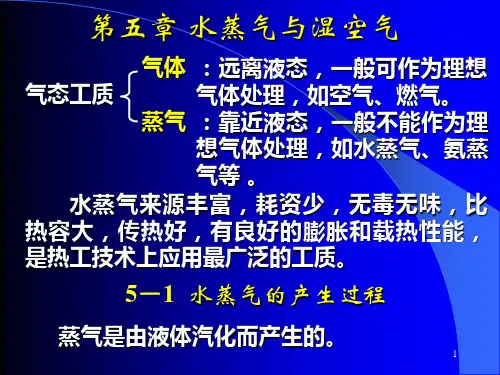
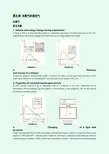
第五章 水蒸气和湿空气水蒸气 英文习题1. Volume and energy change during evaporationA mass of 200 g of saturated liquid water is completely vaporized at constant pressure of 100 kPa. Determine (a) the volume change and (b) the amount of energy added to the water.2.Pressureand volume of a mixtureA rigid tank contains 10 kg of water at 90℃. If 8 kg of the water is in the liquid form and rest is in thevapor form. Determine (a) the pressure in the tank and (b) the volume of the tank.3. Properties of saturated liquid-vapor mixtureAn 80-L vessel contains 4 kg of refrigerant-134a at a pressure of 160 kPa. Determine (a) the temperature of the refrigerant, (b) the quality, (c) the enthalpy of the refrigerant, and (d) the volume occupied by the vapor phase.4.Charging of a rigid tankby steamA rigid insulated tank that is initially evacuated is connected through a valve to a supply line that carries steam at 1 MPa and 300℃. Now the valve is opened, and steam is allowed to flow slowly into the tank until the pressure reaches 1 MPa, at which point the valve is closed.Determine the final temperatureFIGURE 5-1FIGURE 5-2FIGURE 5-3FIGURE 5-4of the steam in the tank.湿空气 英文习题1. The amount of water vapor in room air100 kPa A 5-m ×5-m×3-m room shown in Fig.5-1 contains air at 25℃ and at a relative humidity of 75 percent. Determine (a) the partial pressure of dry air, (b) the specific humidity, (c) the enthalpy per unit mass of the dry air,and (d) the masses of the dry air and water vapor in the room.2. Fogging of the windows in a houseIn cold weather, condensation frequently occurs on the inner surfaces of the windows due to the lower air temperatures near the window surface. Consider a house, shown in Fig.5-6, that contains air at 20℃ and 75 percent relative humidity. At what window temperature will themoisture in the air start condensing on the inner surfaces of thewindows?3. The specific and relative humidity of airThe dry and the wet-bulb temperatures of atmospheric air at 1 atm (101.325 kPa) pressure are measured with a sing psychrometer and determined to be 25℃ and 15℃, respectively. Determine (a0 the specific humidity, (b0 the relative humidity, and © the enthalpy of the air.4. Heating and humidification of airAn air-conditioning system is to take in outdoor air at 10℃ and 30 percent relative humidity at a steady rate of 45 m 3/min and to condition it to 25℃ and 60 percent relative humidity. The outdoor air is first then heated to 22℃ in the heating section and humidified by the injection of hot steam in the humidifying section. Assuming the entire process takes place at a pressure of 100 kPa, determine (a) the rate of heat supply in the heating section and (b) the mass flow rate of the steamrequired in the humidifying section.5. Cooling and dehumidification of airAir enters a window air conditioner at 1 atm, 30℃, and 80 percent relative humidity at rate of 10 m 2/min, and it leaves as saturated air at 14℃. Part of the moisture in the air that condenses during the process is also removed at 14℃. Determine the rates of heat and moisture removal from the air.工程热力学与传热学第五章 水蒸气与湿空气 习题FIGURE 5-5FIGURE 5-6FIGURE 5-7习题1.热水泵必须安装在热水容器下面距容器有一定高度的地方,而不能安装在热水容器的上面,为什么?2.锅炉产生的水蒸气在定温过程中是否满足q=w的关系?为什么?3.有无0℃或低于0℃的蒸汽存在?有无高于400℃的水存在,为什么?4.25MPa的水,是否也象1MPa的水那样经历汽化过程?为什么?5.dh=c p dT适用于任何工质的定压过程,水蒸气定压汽化过程中dT=0,由此得出结论,水定压汽化时dh=c p dT=0,此结论是否正确,为什么?6.试解释湿空气,湿蒸汽,饱和湿空气。
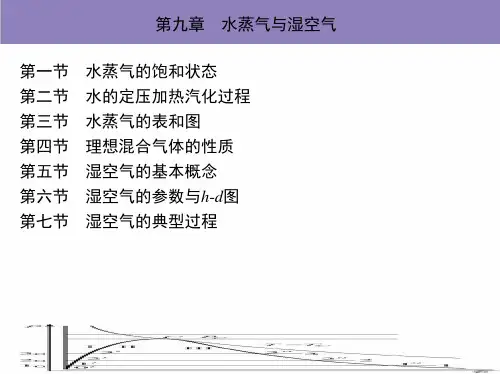
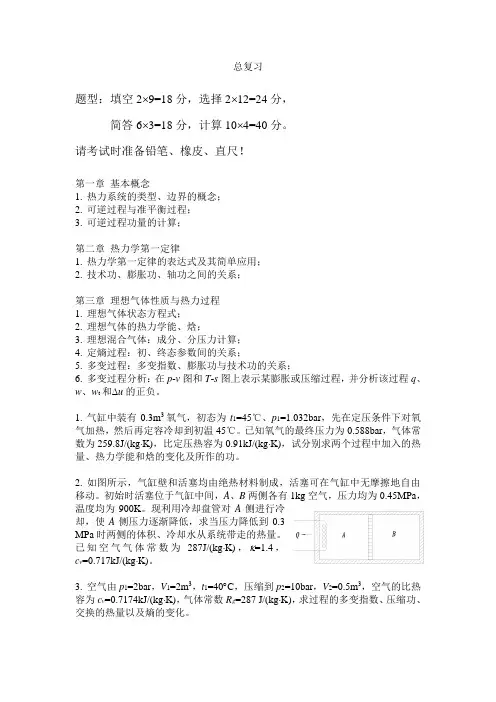
总复习题型:填空2⨯9=18分,选择2⨯12=24分,简答6⨯3=18分,计算10⨯4=40分。
请考试时准备铅笔、橡皮、直尺!第一章基本概念1.热力系统的类型、边界的概念;2.可逆过程与准平衡过程;3.可逆过程功量的计算;第二章热力学第一定律1.热力学第一定律的表达式及其简单应用;2.技术功、膨胀功、轴功之间的关系;第三章理想气体性质与热力过程1.理想气体状态方程式;2.理想气体的热力学能、焓;3.理想混合气体:成分、分压力计算;4.定熵过程:初、终态参数间的关系;5.多变过程:多变指数、膨胀功与技术功的关系;6.多变过程分析:在p-v图和T-s图上表示某膨胀或压缩过程,并分析该过程q、w、w t和∆u的正负。
1.气缸中装有0.3m3氧气,初态为t1=45℃、p1=1.032bar,先在定压条件下对氧气加热,然后再定容冷却到初温45℃。
已知氧气的最终压力为0.588bar,气体常数为259.8J/(kg⋅K),比定压热容为0.91kJ/(kg⋅K),试分别求两个过程中加入的热量、热力学能和焓的变化及所作的功。
2.如图所示,气缸壁和活塞均由绝热材料制成,活塞可在气缸中无摩擦地自由移动。
初始时活塞位于气缸中间,A、B两侧各有1kg空气,压力均为0.45MPa,温度均为900K。
现利用冷却盘管对A侧进行冷却,使A侧压力逐渐降低,求当压力降低到0.3MPa时两侧的体积、冷却水从系统带走的热量。
已知空气气体常数为287J/(kg⋅K),κ=1.4,c v=0.717kJ/(kg⋅K)。
3.空气由p1=2bar,V1=2m3,t1=40︒C,压缩到p2=10bar,V2=0.5m3,空气的比热容为c v=0.7174kJ/(kg⋅K),气体常数R g=287 J/(kg⋅K),求过程的多变指数、压缩功、交换的热量以及熵的变化。
第四章热力学第二定律1.卡诺循环与逆卡诺循环的经济性指标;2.利用克劳休斯积分不等式来判断热力循环的可行性和可逆性;3.利用熵变来判断热力过程的可行性和可逆性;4.孤立系统熵增原理、作功能力的损失;5.有两个质量均为100kg、比热均为1kJ/(kg K)、但温度不同的物体A和B,物体A的温度为1000K,物体B的温度为500K。
![(6)第五章水蒸汽热力性质_热工基础 [兼容模式].](https://uimg.taocdn.com/241e41e39ec3d5bbfd0a7444.webp)

湿空气
含有水蒸气的空气称为湿空气。
大气中永远包含一定量的水蒸气,绝对干的空气在自然界中是不存在的,在空调系统中将干空气看作一个整体,湿空气=干空气+水蒸气。
湿空气是干空气和水蒸气组成的混合气体,湿空气的压力等于干空气的分压力Pg与水蒸气的分压力Pzq之和。
(1)饱和空气。
湿空气中水蒸气分压力有一个最大值,这个最大值就称为该温度下的饱和水蒸气分压力Pbh在大气中,如从水蒸发为汽的数量与空气中水蒸气凝结为水的数量相等,此时大气中所含的水蒸气数量达到最大限度,即水蒸气处于饱和状态。
这种湿空气就是干空气和饱和水蒸气的混合物,称为饱和空气。
(2)未饱和空气。
湿空气中水蒸气的分压力低于其相同温度下的饱和空气水蒸气的分压力,这时的水蒸气处于过热状态,这种湿空气就是干空气和过热水蒸气的混合物,称为未饱和空气。
由此可见,在一定温度条件下,湿空气中水蒸气分压力的大小是衡量水蒸气含量即空气干燥或潮湿的指标。
温度越高,水蒸气的分压力就越大。

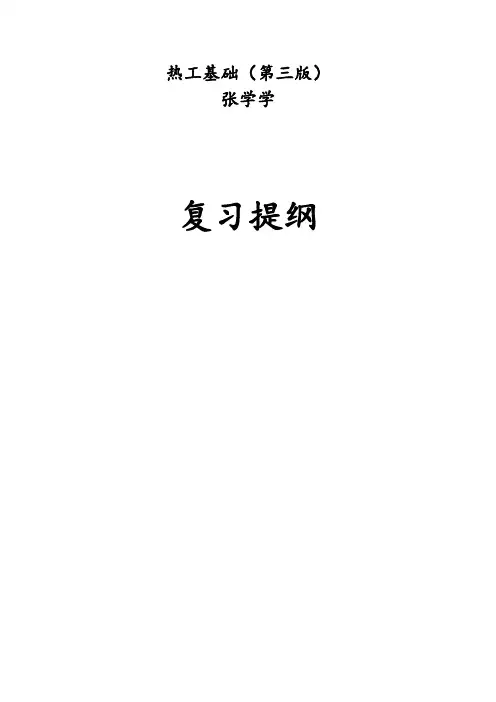
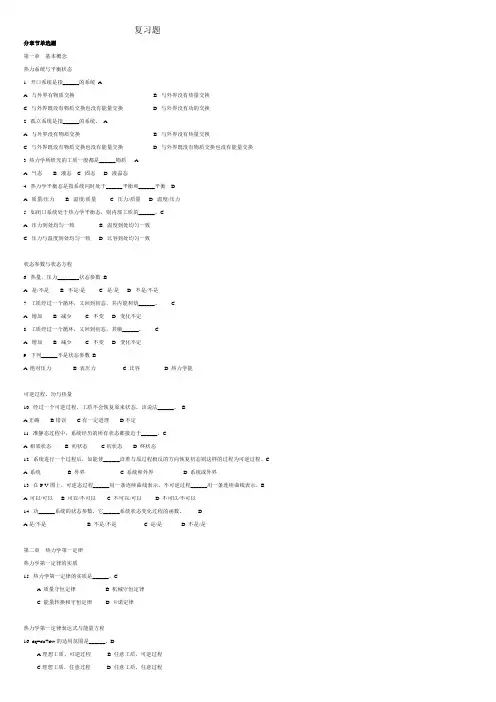
复习题分章节单选题第一章基本概念热力系统与平衡状态1. 开口系统是指______的系统AA. 与外界有物质交换B. 与外界没有热量交换C. 与外界既没有物质交换也没有能量交换D. 与外界没有功的交换2. 孤立系统是指______的系统。
AA. 与外界没有物质交换B. 与外界没有热量交换C. 与外界既没有物质交换也没有能量交换D. 与外界既没有物质交换也没有能量交换3 热力学所研究的工质一般都是______物质 AA. 气态B. 液态C. 固态D. 液晶态4. 热力学平衡态是指系统同时处于______平衡和______平衡 DA. 质量/压力B. 温度/质量C. 压力/质量D. 温度/压力5. 如闭口系统处于热力学平衡态,则内部工质的______。
CA. 压力到处均匀一致B. 温度到处均匀一致C. 压力与温度到处均匀一致D. 比容到处均匀一致状态参数与状态方程6. 热量、压力________状态参数BA. 是/不是B. 不是/是C. 是/是D. 不是/不是7. 工质经过一个循环,又回到初态,其内能和焓______。
CA. 增加B. 减少C. 不变D. 变化不定8. 工质经过一个循环,又回到初态,其熵______。
CA. 增加B. 减少C. 不变D. 变化不定9. 下列______不是状态参数BA 绝对压力B 表压力C 比容D 热力学能可逆过程、功与热量10. 经过一个可逆过程,工质不会恢复原来状态,该说法______。
BA正确B错误C有一定道理D不定11. 准静态过程中,系统经历的所有状态都接近于______。
CA 相邻状态B 初状态C初状态 D 终状态12. 系统进行一个过程后,如能使______沿着与原过程相反的方向恢复初态则这样的过程为可逆过程。
CA 系统B 外界C 系统和外界D 系统或外界13. 在P-V图上,可逆态过程______用一条连续曲线表示,不可逆过程______用一条连续曲线表示。

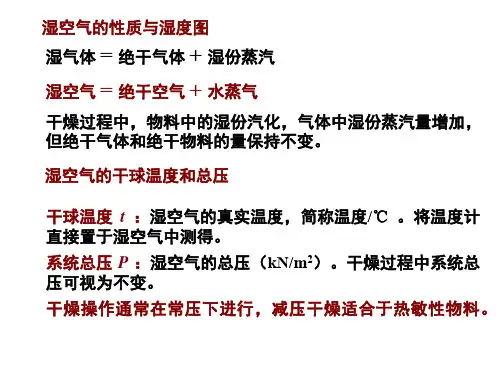
《工程热力学与传热学》课程教学大纲Thermodynamics and Heat Transfer课程名称:工程热力学与传热学课程编号:130106009课程性质:专业基础课(必修)学时:32(含4学时实验学时)学分:2.0适用对象:机械设计制造及其自动化专业、机械设计制造及其自动化专业(卓越计划试点专业)、机械设计制造及其自动化专业(核电装备工程)、机械设计制造及其自动化专业(机械电子)、材料控制与成型专业先修课程:《高等数学》、《大学物理》等课程负责人:肖佩林大纲执笔人:肖佩林审核人:罗金良一、课程目标该课程为专业基础课程可以支撑毕业要求1、2的达成。
在阐述热力学普遍原理、热量传递机理的基础上,从工程观点来研究热能与其他形式能量间的转换规律、热量传递规律,研究热力学原理、传热学原理在技术上的各种具体应用。
通过本课程的学习可以使同学们掌握遵循能量传递和转换技术的客观规律来合理组织和优化各种热力系统的工程方法;能有效地使用增强或削弱传热的措施来解决工程实际问题。
二、课程的主要教学内容和教学方法第一篇工程热力学第一章基本概念1.基本内容:热力系统;平衡状态及状态参数;状态方程与状态参数坐标图;准平衡过程与可逆过程;功量与热量。
2.教学基本要求:了解:热功转换关系;热力循环及其性能指标。
掌握:热力系统及其分类;平衡状态及状态参数;状态参数的数学特征;准平衡过程和可逆过程的定义及区分;可逆过程功和热量的计算。
3.教学重点难点:重点:热力系统及其分类;平衡状态及状态参数;可逆过程与准平衡过程的区别与联系。
难点:准平衡过程和可逆过程。
4.教学方法:多媒体教学法、提问法、课堂讨论法。
5.与毕业要求的对应关系:学生能正确理解热能转换中常用的一些术语,基本概念;掌握热力系及其分类,平衡状态和状态参数,状态参数的数学特征;了解实际热力循环的类型及其性能指标。
第二章热力学第一定律1.基本内容:热力系统的储存能;热力学第一定律的实质;闭口系统的热力学第一定律表达式;开口系统的稳定流动能量方程式;稳定流动能量方程式的应用。